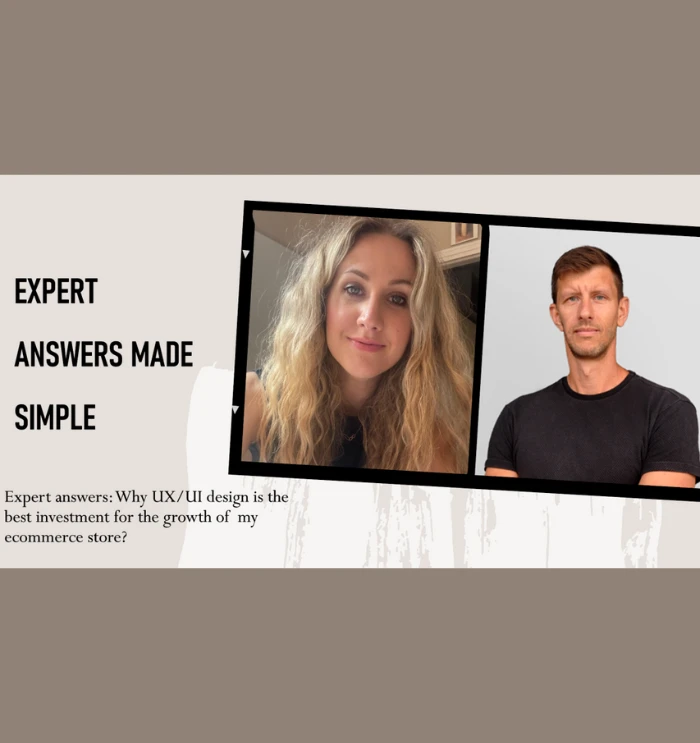Homepage » Episode 2#: UX/UI Design. And why is it the best investment for the growth of my ecommerce store?
3 Questions to the Expert and 3 answers that explain complex phenomena in a simple way. The more often I talked to Piotr Młynarczyk, the more I became convinced that I was discussing with a real “artist of applied art”. The art that is also innovative and perfectly communicated with the recipient or a client. Piotr adheres to these principles on the daily basis. Always professional and extremely involved in projects, but above all, open, friendly and warm person.
I strongly recommend an encounter with Piotr as well as reading a short part of the series “3 Questions to the Expert” – 3 answers that explain complex phenomena in a simple way, where Piotr explains „Why UX/UI design is the best investment for the growth of own ecommerce store?”
Ania Modrzewska: From time to time I have encountered the customers who want a new design or a completely new website for an online store that will sell products. Piotr how would you design such a store?
Piotr Młynarczyk: I would start designing a store that effectively sells products by conducting thorough analysis of your target group and competition to understand customers’ purchasing behaviors. Then, I would propose a clear category structure and intuitive navigation that will allow users to quickly find the products they’re looking for. The homepage showcase bestsellers and promotions, and product cards will be equipped with high-quality images, clear descriptions, and prominent “Add to Cart” buttons. I will pay particular attention to the purchasing process: minimizing the number of steps from the cart to the order completion, which will significantly impact the conversion rate. I will also implement elements that build trust, such as customer reviews, security certificates, and transparent shipping information. The entire design will be responsive, so the store works perfectly on both computers and mobile devices, from which most purchases are currently made. However, even the best-designed website won’t sell without proper marketing support and efficient organization of business processes. On the other hand, great marketing may not bring results if users encounter usability problems on the site. Therefore, as a designer, I always emphasize the importance of a holistic approach and close cooperation between marketing, sales, customer service, and IT departments. Design is important, but it is not the only element of the sales puzzle.
Ania Modrzewska: Customers might doubt about the price of the project which may be perceived as a very high. Therefore they might consider ordering the website construction directly from a web developer, without a design. How about that?
Piotr Młynarczyk: I understand the concerns about the cost, still it’s worth looking at UX/UI design as an investment that will pay off in the form of higher sales and satisfied customers. In my experience, making changes to a finished website is 5-10 times more expensive than modifications at the design stage – it’s like building a house without an architectural project, where every correction requires breaking walls. A professionally designed interface can increase conversion by up to 200%, which means that if your store generates, for example 10,000 PLN per month, thanks to a good design it can be 20,000 PLN or more. Very often, we observe situations where clients, wanting to save on the project, later spend many times more on correcting a website that does not meet their expectations or does not generate sales. A web developer focuses on coding and technical functionalities, while a UX/UI designer focuses on „user psychology”, purchasing paths, and elements that actually influence on purchasing decisions.
Ania Modrzewska: Once I have the website design, I’d like to order designs for other advertising materials to promote my store. What do I need to pay attention to when designing flyers, banners, posters, etc.?
Piotr Młynarczyk: When we are designing advertising materials, it is crucial to maintain visual consistency with the online store. I will use the same colors, typography, and graphic elements to build brand recognition. I create a style guide containing all branding guidelines that will serve as the basis for designing each advertising material, ensuring a professional and unified company image. Each advertising material will be designed with its specific context and purpose in mind – for example: a flyer must be legible and persuasive in printed form, an online banner must attract attention within a few seconds, and a poster should be visible and communicative from a greater distance. We also take care of the technical aspects of preparing projects for different media – appropriate formats, resolutions, and color specifications for print and digital media, so that the materials look professional regardless of where they are published.
